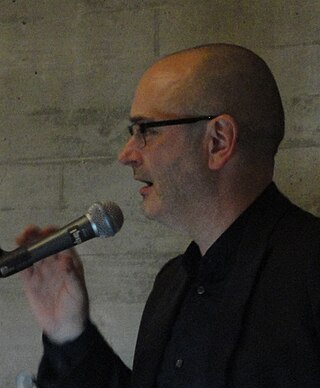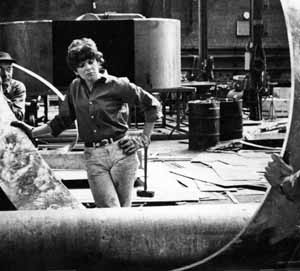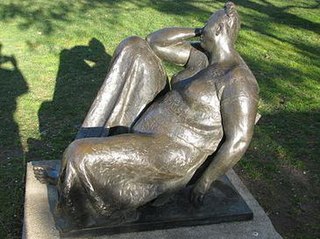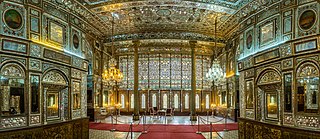
You Are Not Yourself is a work of appropriation art by Barbara Kruger. Created in 1981, [1]

You Are Not Yourself is a work of appropriation art by Barbara Kruger. Created in 1981, [1]
You Are Not Yourself depicts a woman examining herself in a mirror that has presumably been struck and shattered by a bullet. [2] The text "You are not yourself" appears on the photograph, surrounding the image of the woman. The work was included in the exhibition "Barbara Kruger: Belief + Doubt" at the Hirshhorn Museum in Washington, D.C., which has been on view since 2012. [2] [3]
As is the case with much of Kruger's art, You Are Not Yourself is often interpreted with a feminist analysis. Critics have discussed the gendered implications of the image, noting that the woman's shattered reflection suggests the existence of women in society is inherently fragmented. Women are held to many standards and forced to adopt conflicting roles only to become an amalgamation of other's expectations and assumptions; when a woman finally has a moment for self-reflection (or, as Kruger suggests, a chance to catch a glance in the mirror) she finds that she is "not herself". [4] The text itself resembles crudely cut and pasted letters that create a jarring tone and echo the theme of breaking. Some critics interpret the image as a call for viewers to consider their own subjectivity and evaluate the societal messages that they may be receiving. [4] In 1991 interview, Kruger said: "I would venture to guess that many people heed their mirrors at least five times a day and that vigilance certainly can structure physical and psychic identity." [5]
The use of pronouns in Kruger's work is often discussed as a potential source of meaning. In You Are Not Yourself, questions have been raised about the identity of the subject that Kruger hails: who is the "you" in question? You Are Not Yourself features a shattered mirror that has been interpreted to symbolize the reflection of each unique viewer, suggesting that the embedded message is directed towards everyone who views the piece. [6] This image, like others in Kruger's oeuvre, has been used to discuss aspects of critical theory concerning perception and the nature of self.

Douglas Gordon is a Scottish artist. He won the Turner Prize in 1996, the Premio 2000 at the 47th Venice Biennale in 1997 and the Hugo Boss Prize in 1998. He lives and works in Berlin, Germany.

The Hirshhorn Museum and Sculpture Garden is an art museum beside the National Mall in Washington, D.C., United States. The museum was initially endowed during the 1960s with the permanent art collection of Joseph H. Hirshhorn. It was designed by architect Gordon Bunshaft and is part of the Smithsonian Institution. It was conceived as the United States' museum of contemporary and modern art and currently focuses its collection-building and exhibition-planning mainly on the post–World War II period, with particular emphasis on art made during the last 50 years.

Anne Truitt, born Anne Dean, was an American sculptor of the mid-20th century.
Barbara Kruger is an American conceptual artist and collagist associated with the Pictures Generation. She is most known for her collage style that consists of black-and-white photographs, overlaid with declarative captions, stated in white-on-red Futura Bold Oblique or Helvetica Ultra Condensed text. The phrases in her works often include pronouns such as "you", "your", "I", "we", and "they", addressing cultural constructions of power, identity, consumerism, and sexuality. Kruger's artistic mediums include photography, sculpture, graphic design, architecture, as well as video and audio installations.
Renee Stout is an American sculptor and contemporary artist known for assemblage artworks dealing with her personal history and African-American heritage. Born in Kansas, raised in Pittsburgh, living in Washington, D.C., and connected through her art to New Orleans, her art reflects this interest in African diasporic culture throughout the United States. Stout was the first American artist to exhibit in the Smithsonian's National Museum of African Art.

Irene Rice Pereira was an American abstract artist, poet and philosopher who played a major role in the development of modernism in the United States. She is known for her work in the genres of geometric abstraction, abstract expressionism and lyrical abstraction, as well as her use of the principles of the Bauhaus school. Her paintings and writings were significantly influenced by the complex intellectual currents of the 20th century.

Beverly Pepper was an American sculptor known for her monumental works, site specific and land art. She remained independent from any particular art movement. She lived in Italy, primarily in Todi, since the 1950s.

Feminist art is a category of art associated with the late 1960s and 1970s feminist movement. Feminist art highlights the societal and political differences women experience in their lives. The goal of this art form is to bring a positive and understanding change to the world, leading to equality or liberation. Media used range from traditional art forms such as painting to more unorthodox methods such as performance art, conceptual art, body art, craftivism, video, film, and fiber art. Feminist art has served as an innovative driving force toward expanding the definition of art by incorporating new media and a new perspective.
Daniel Rozin is an Israeli-American artist working in the area of interactive digital art. As an interactive artist Rozin creates installations and sculptures that have the unique ability to change and respond to the presence and point of view of the viewer. In many cases the viewer becomes the contents of the piece and in others the viewer is invited to take an active role in the creation of the piece.

Gregory Joseph Gillespie was an American magic realist painter.

Alyson Shotz is an American sculptor based in Brooklyn, New York. She is known for experiential, large-scale abstract sculptures and installations inspired by nature and scientific concepts, which manipulate light, shadow, space and gravity in order to investigate and complicate perception. Writers suggest her work challenges tenets of monumental, minimalist sculpture—traditionally welded, solid, heavy and static—through its accumulation of common materials in constructions that are often flexible, translucent, reflective, seemingly weightless, and responsive to changing conditions and basic forces. Sculpture critic Lilly Wei wrote, "In Shotz’s realizations, the definition of sculpture becomes increasingly expansive—each project, often in series, testing another proposition, another possibility, another permutation, while ignoring conventional boundaries."

Proper right and proper left are conceptual terms used to unambiguously convey relative direction when describing an image or other object. The "proper right" hand of a figure is the hand that would be regarded by that figure as its right hand. In a frontal representation, that appears on the left as the viewer sees it, creating the potential for ambiguity if the hand is just described as the "right hand".

Antipodes is a public artwork by American sculptor Jim Sanborn located outside of the Hirshhorn Museum and Sculpture Garden in Washington, DC, United States.

Seated Yucatán Woman is a bronze sculpture, by Francisco Zúñiga. It is an edition of four, one of which is located at the Hirshhorn Museum and Sculpture Garden.

Hotel by a Railroad is a painting completed in 1952 by the American realist painter and printmaker Edward Hopper. The work is an oil on canvas, measuring 101.9 x 79.3 cm. It resides in the collection of the Hirshhorn Museum and Sculpture Garden.
Liz Larner is an American installation artist and sculptor living and working in Los Angeles.

Linn Meyers is an American, Washington, D.C.–based artist. Her work has been exhibited in the United States and abroad. She is known for her hand-drawn lines and tracings for site-specific installations.
Takeshi Murata is an American contemporary artist who creates digital media artworks using video and computer animation techniques. In 2007 he had a solo exhibition, Black Box: Takeshi Murata, at the Hirshhorn Museum and Sculpture Garden in Washington, D.C. His 2006 work "Pink Dot" is in the Hirshhorn's permanent collection, and his 2005 work "Monster Movie" is in the permanent collection of the Smithsonian American Art Museum. His 2013 short film "OM Rider" was selected to screen as an animated short film at the 2015 Sundance Film Festival.

Āina-kāri is a kind of interior decoration where artists assemble finely cut mirrors together in geometric, calligraphic or foliage forms. This creates a beautiful shining surface covered with complex facets, reflecting light as intricate abstract patterns or glittering reflections. Beside their decorative use, this art an used as a strong durable cover for an interior space of a building. This type of mosaic work is commonly done in Iran, Pakistan and is also found is Mughal era buildings of India.